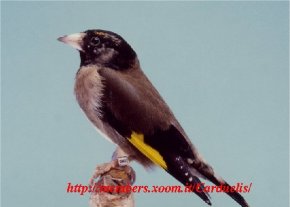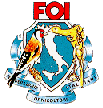|
|||||
|
|||||
|
MELANIC EUROPEAN GOLDFINCHES Simple aberration or mutation? | |||||

Photo 4 - Melanic european Goldfinch of feminine gender
related to an unbalanced diet, for example too high quantity of hemp seeds or mealworms). By other hands, I have also found other interesting hypotheses consulting some books dedicated to the European Finches, written by Marcel Ruelle, famous Belgian studious, director of "The Ornithologue" and published by the Fèdèration Ornithologique Wallonne (Belgium), in particular:
In fact, in such books, we may read:
... as not hereditary aberrations, the professor
Maurice Pomarèd cites the melanism, characterized for abundance of
the black melanin in the plumage. The bird can become entirely black... and again:
... in the magazine "Journal des Oiseaux" of April 1988
has been published a photography of a melanic European goldfinch.
Maurice Pomaréde has commented such photography as follow:
"In such melanic european goldfinch the red
|
and white of head have been
replaced by black melanin but the remaining part of the plumage is
apparently normal. The plumage of such bird does not belong to the classic melanism,
characterized by a strong melanization related to whole plumage and often
of endocrine origin.
The melanism of this European goldfinch is localized to the head where
the mutation has allowed the extension of melanin and the disappearance
of the colorful mask".
Maurice Pomarède bases his sentence on studies of various birds and
in particular the one related to the Gouldian Finch, he esteems that the
head colors depend on dominant factors inhibiting the depositing of melanin.
Many hybrids, obtained by the European goldfinch, inherit its mask,
this is tending to demonstrate that such inheritance is due to a dominant factor
whose action is completed by another factor related to the nature of carotenoid. we may read again (comment to another melanic European goldfinch, see photography 5):
Maurice Pomaréde reports us an article and
a photography published by "Italia Ornitologica" on February 1992
(see photo 5)
and by "Uccelli", on December 1991 and on April 1992
(see photo 6) , commenting:
"this subject is truly black, the head, the back, the wings, the chest and
the tail are entirely black, the abdomen is grayish. A light tawny soffusion
seems however present at the level of cheeks, but it's very limited.
An important fact, it does not remain any traces of yellow band on the wings and
the red mask and white color on the head, the tail is completely black
as the beak tip as.
We know, and the hybridization shows it to us, that the depositing of melanin
is normally inhibited at the mask level caused by a dominant gene.
Foto 5 - Black European Goldfinch published by "Italia Ornitologica" on February 1992

|
||||
|
|||||
|
Copyright © 1999 by Angelo Fumagalli - All rights reserved.
No part of information and images, contained in this article may be used,
copied, photocopied, reproduced, translate in whichever other language or
format, supplied or however made available to other persons without the
written consent of the Author.
| |||||





